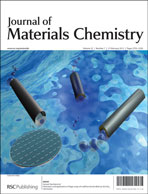Novel hydrogel pore-filled composite membranes with tunable and temperature-responsive size-selectivity†
Abstract
Hydrogel pore-filled composite membranes (HPFCM) based on polyethylene terephthalate (PET) track-etched membranes with pore diameters between 200 and 5000 nm and temperature-responsive poly(N-isopropylacrylamide) (PNIPAAm) hydrogels were successfully prepared. A premodification of the pore walls by grafted linear PNIPAAm led to stable anchoring of crosslinked PNIPAAm prepared in a subsequent step. Proper tuning of photopolymerization conditions resulted in a desired microstructure of the hydrogels and thus tailored barrier properties of the composite membranes. The very interesting separation performance of HPFCM was due to diversification of the hydrogel network that caused adjustable sieving properties via synthesis conditions and also largely switchable barrier properties in response to the temperature. The interplay between the immobilized hydrogel and various pore sizes of the membrane support was also investigated. The base membrane provides mechanical support and confines the hydrogel within its pores, and it thus allows using the hydrogel mesh size for size-selective solute transport. Completely stable and selective HPFCM were only obtained with base pore sizes of about 2 μm or smaller. The size-selectivity (molecular weight cut-off) of the same HPFCM was higher under diffusive than under convective flow conditions; this is presumably mainly caused by elasticity deformation of the hydrogel network. The apparent cut-off from diffusion experiments was well correlated to the mesh-size of the hydrogel determined from the Darcy model applied to permeability data obtained under convective flow conditions. Upon temperature increase beyond 32 °C, flux increased and rejection decreased very strongly; this remarkable change between


 Please wait while we load your content...
Please wait while we load your content...